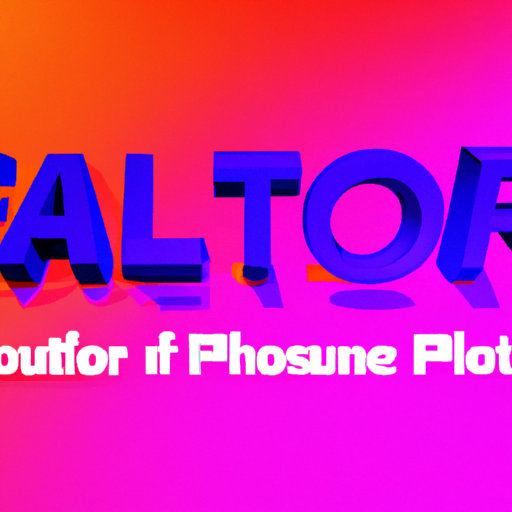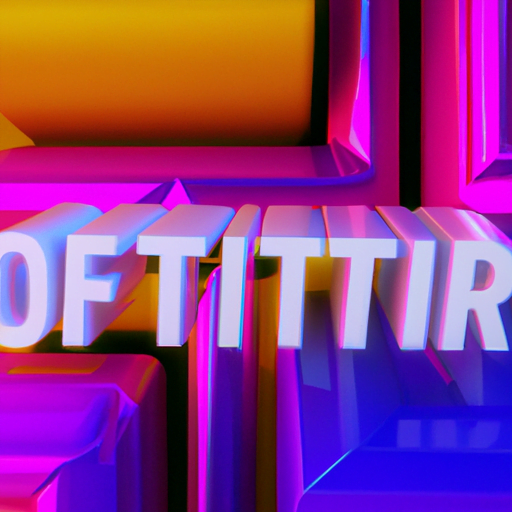
-
Table of Contents
- Exploring the Future of 3D Typography in Graphic Design
- The Rise of 3D Typography
- Current Trends in 3D Typography
- 1. Kinetic Typography
- 2. Mixed Media Typography
- 3. Isometric Typography
- 4. Augmented Reality Typography
- The Impact of 3D Typography on Graphic Design
- 1. Enhanced Visual Appeal
- 2. Improved User Experience
- 3. Pushing the Boundaries of Creativity
- 4. Brand Differentiation
- Case Studies: Successful Implementation of 3D Typography
- 1. Nike Air Max Day Campaign
- 2. Coca-Cola’s “Taste the Feeling” Campaign
- The Future of 3D Typography
- 1. Integration with Virtual Reality
Exploring the Future of 3D Typography in Graphic Design

Typography has always played a crucial role in graphic design, conveying messages and evoking emotions through the arrangement of letters and words. With the rapid advancements in technology, designers are now able to push the boundaries of typography even further, exploring new dimensions and creating captivating 3D typographic designs. In this article, we will delve into the future of 3D typography in graphic design, examining its potential, current trends, and the impact it has on the industry.
The Rise of 3D Typography
3D typography has gained significant popularity in recent years, thanks to advancements in software and rendering capabilities. Designers are now able to create three-dimensional letterforms that add depth, texture, and realism to their designs. This shift towards 3D typography has been driven by several factors:
- Technological advancements: The development of powerful graphic design software and rendering engines has made it easier for designers to create complex 3D typographic designs. Software like Adobe Illustrator and Cinema 4D provide designers with the tools they need to bring their ideas to life.
- Increased demand for immersive experiences: As consumers become more accustomed to immersive experiences in various forms of media, there is a growing demand for 3D typography that can create a sense of depth and realism. Brands and businesses are leveraging this demand to create visually stunning designs that capture the attention of their target audience.
- Advancements in printing technology: The evolution of 3D printing technology has opened up new possibilities for designers to bring their 3D typographic designs into the physical world. This has led to the creation of unique and innovative products, such as 3D-printed sculptures and signage.
Current Trends in 3D Typography
As with any design discipline, 3D typography is constantly evolving, with new trends emerging and shaping the industry. Let’s take a look at some of the current trends in 3D typography:
1. Kinetic Typography
Kinetic typography involves animating text to create movement and bring it to life. This trend has gained popularity in recent years, with designers using 3D typography to create dynamic and engaging animations for videos, websites, and advertisements. Kinetic typography adds an extra layer of visual interest and can effectively convey messages in a captivating way.
2. Mixed Media Typography
Mixed media typography combines different materials and textures to create visually striking designs. Designers are experimenting with combining 3D typography with elements such as photography, illustrations, and even physical objects. This trend allows for unique and innovative designs that push the boundaries of traditional typography.
3. Isometric Typography
Isometric typography involves creating three-dimensional letterforms using an isometric grid. This trend has gained popularity due to its clean and modern aesthetic. Isometric typography is often used in branding and advertising to create visually appealing designs that stand out.
4. Augmented Reality Typography
With the rise of augmented reality (AR) technology, designers are exploring the use of 3D typography in AR experiences. AR typography allows users to interact with three-dimensional letterforms in real-world environments, creating immersive and interactive experiences. This trend has significant potential for advertising, gaming, and other industries.
The Impact of 3D Typography on Graphic Design
The emergence of 3D typography has had a profound impact on the field of graphic design. It has opened up new possibilities for designers to create visually stunning and immersive designs that capture the attention of their audience. Here are some of the key impacts of 3D typography:
1. Enhanced Visual Appeal
3D typography adds depth, texture, and realism to designs, making them visually appealing and engaging. By incorporating three-dimensional letterforms, designers can create designs that stand out and leave a lasting impression on viewers. This enhanced visual appeal can be particularly effective in advertising and branding, where capturing attention is crucial.
2. Improved User Experience
With the rise of interactive and immersive experiences, 3D typography can greatly enhance the user experience. Whether it’s through animated kinetic typography or augmented reality typography, users can engage with designs in a more interactive and meaningful way. This can lead to increased user engagement and a stronger connection between the brand and its audience.
3. Pushing the Boundaries of Creativity
3D typography allows designers to push the boundaries of creativity and explore new possibilities. By combining different materials, textures, and techniques, designers can create unique and innovative designs that were not possible with traditional typography. This opens up new avenues for self-expression and artistic exploration.
4. Brand Differentiation
In a crowded marketplace, standing out from the competition is crucial for brands. 3D typography provides a powerful tool for brand differentiation. By incorporating three-dimensional letterforms into their designs, brands can create a distinct visual identity that sets them apart from their competitors. This can help establish brand recognition and build a strong brand image.
Case Studies: Successful Implementation of 3D Typography
Let’s take a look at some real-world examples of successful implementation of 3D typography:
1. Nike Air Max Day Campaign
Nike’s Air Max Day campaign in 2019 featured a series of 3D typographic designs that showcased the iconic Air Max sneakers. The campaign used 3D typography to create dynamic and visually stunning visuals that captured the essence of the Air Max brand. The designs were used across various marketing channels, including social media, billboards, and in-store displays, creating a cohesive and impactful campaign.
2. Coca-Cola’s “Taste the Feeling” Campaign
Coca-Cola’s “Taste the Feeling” campaign incorporated 3D typography to create a sense of depth and realism. The campaign featured 3D letterforms made of various materials, such as ice, bubbles, and glass, to represent the different flavors and sensations of Coca-Cola. The use of 3D typography added an extra layer of visual interest and effectively conveyed the brand’s message.
The Future of 3D Typography
The future of 3D typography in graphic design looks promising, with continued advancements in technology and increasing demand for immersive experiences. Here are some potential developments we can expect to see:
1. Integration with Virtual Reality
As virtual reality (VR) technology becomes more accessible, designers will likely explore the integration of 3D typography with VR experiences. This could involve creating three-dimensional letterforms that users can interact with in virtual environments, further blurring the lines between the physical and digital worlds.
